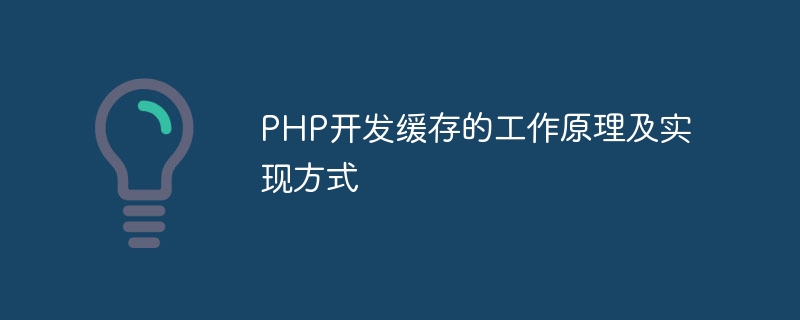

The working principle and implementation method of PHP development caching
Caching is a commonly used technical means to improve website performance. It can store some frequently accessed data Save it in memory for quick retrieval, reduce the number of database queries, and thus improve the response speed of the website. In PHP development, there are many ways to implement caching. The following will introduce its working principle and implementation method in detail, and provide corresponding code examples.
1. The working principle of caching
The working principle of caching can be divided into the following steps:
Through the above workflow, caching can be achieved to improve website performance.
2. How to implement caching
In PHP development, there are many ways to implement caching. The following will introduce two common methods: file caching and Memcached caching.
(1) Check cache: first determine whether the cache file exists, and if it exists, determine whether the cache has expired. You can save the cache expiration time in the content of the cache file and then compare it with the current time.
(2) Get the cache: If the cache has not expired, read the contents of the cache file directly, deserialize it into original data, and return it to the user.
(3) Update cache: If the cache expires or does not exist, perform a database query and save the query results to the cache file. When saving, the data can be serialized to facilitate subsequent reading and deserialization operations.
The following is a simple file caching code example:
<?php
function getDataFromCache($cacheKey, $expireTime) {
$cacheFile = '/path/to/cache/' . md5($cacheKey) . '.cache';
if (file_exists($cacheFile) && (filemtime($cacheFile) + $expireTime > time())) {
$data = file_get_contents($cacheFile);
return unserialize($data);
}
return false;
}
function saveDataToCache($cacheKey, $data) {
$cacheFile = '/path/to/cache/' . md5($cacheKey) . '.cache';
$data = serialize($data);
file_put_contents($cacheFile, $data);
}
?>(1) Connect to the Memcached server: Use the Memcached extension function to connect to the Memcached server through the connect method.
(2) Check cache: Use the get method to obtain cache data from the Memcached server.
(3) Get the cache: If the cache data exists, return the data directly to the user.
(4) Update cache: If the cache data does not exist, perform a database query and save the query results to the Memcached server.
The following is a simple Memcached caching code example:
<?php
$memcached = new Memcached();
$memcached->addServer('localhost', 11211);
function getDataFromCache($cacheKey) {
global $memcached;
return $memcached->get($cacheKey);
}
function saveDataToCache($cacheKey, $data, $expireTime) {
global $memcached;
$memcached->set($cacheKey, $data, $expireTime);
}
?>The above is the implementation and code example of file caching and Memcached caching. Based on actual business needs and environment configuration, you can choose a caching method that suits you for development to improve website performance and user experience.
Summary
Caching is an important performance optimization technology. In PHP development, it can be achieved through file caching and Memcached caching. Different caching methods differ in implementation details and performance. Developers can choose a suitable method for development and application based on their own needs and actual conditions. Through reasonable use of cache, the response speed of the website can be improved and the user experience can be improved.
The above is the detailed content of How PHP development cache works and how to implement it. For more information, please follow other related articles on the PHP Chinese website!




